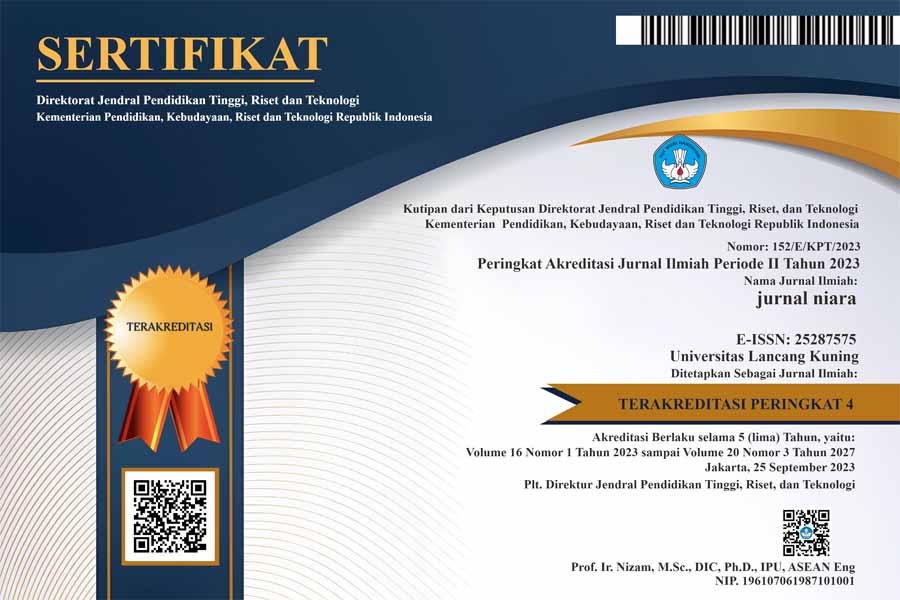Peatlands Restoration As A Potential Solution To Resolve Peatlands Damage Based On Sustainable Development Goals (SDGS) In Sungai Tohor, Indonesia
Abstract
Peatland restoration is a potential solution to resolve peatland damage but faces an economic-social-environmental exchange (Sustainable Development Goals) that results in strong disagreements between stakeholders who have different interests such as company, community and local or regional government concessions. Successful peatland restoration will depend on how various priorities have been reconciled, as much as it depends on improving governance and cross-sector collaboration well done. The purpose of this paper is to find a solution how to be managing peatlands in Sungaitohor, Indonesia. We use social maps to show the communities concern to restoration of degraded peatland, we try to compare the level of public awareness to prevention efforts and the restoration of peatland damaged by fires Forest and peatlands. The findings of this paper are social map, that explain the community’s participation to efforts of peatland restoration in Sungai tohor, Indonesia.
Downloads
References
[2]. Gupta, J., & Vegelin, C. (2016). Sustainable Development Goals And Inclusive Development. International Environmental Agreements: Politics, Law And Economics. Https://Doi.Org/10.1007/S10784-016-9323-Z
[3]. Hariyanto, B. (2016). Manfaat Tanaman Sagu (Metroxylon Sp) Dalam Penyediaan Pangan Dan Dalam Pengendalian Kualitas Lingkungan. Jurnal Teknologi Lingkungan. Https://Doi.Org/10.29122/Jtl.V12i2.1246
[4]. Ishartono & Raharjo, S. T. (2015). Sustainable Development Goals (Sdgs) Dan Pengentasan Kemiskinan. Social Work Jurnal.
[5]. Jong, F. S. (2018). An Overview Of Sago Industry Development, 1980s-2015. In Sago Palm: Multiple Contributions To Food Security And Sustainable Livelihoods. Https://Doi.Org/10.1007/978-981-10-5269-9_6
[6]. Laufa, T., & Kavanamur, D. (2008). Biodiplomacy Of The Sago Palm In Papua New Guinea - A Systems Thinking Approach. Contemporary Png Studies.
[7]. Metaragakusuma, A. P., Katsuya, O., & Bai, H. (2016). An Overview Of The Traditional Use Of Sago For Sago-Based Food Industry In Indonesia. Kne Life Sciences. Https://Doi.Org/10.18502/Kls.V3i3.382
[8]. Ming, R. Y. C., Sobeng, Y., Zaini, F., & Busri, N. (2018). Suitability Of Peat Swamp Areas For Commercial Production Of Sago Palms: The Sarawak Experience. In Sago Palm: Multiple Contributions To Food Security And Sustainable Livelihoods. Https://Doi.Org/10.1007/978-981-10-5269-9_7
[9]. Muhidin, Leomo, S., Alam, S., & Wijayanto, T. (2016). Comparative Studies On Different Agroecosystem Base On Soil Physicochemical Properties To Development Of Sago Palm On Dryland. International Journal Of Chemtech Research.
[10]. Nusawakan, M., Kunu, P., & Luhukay, M. (2017). Kondisi Lahan Tumbuhan Sagu Di Desa Rumahkay Kecamatan Amalatu Kabupaten Seram Bagian Barat Provinsi Maluku. Jurnal Budidaya Pertanian. Https://Doi.Org/10.30598/Jbdp.2017.13.2.84
[11].Sharma, R. K., & Kharub, M. (2015). Qualitative And Quantitative Evaluation Of Barriers Hindering The Growth Of Msmes. International Journal Of Business Excellence, 8(6), 1–17. Https://Doi.Org/10.1504/Ijbex.2015.072307
.















